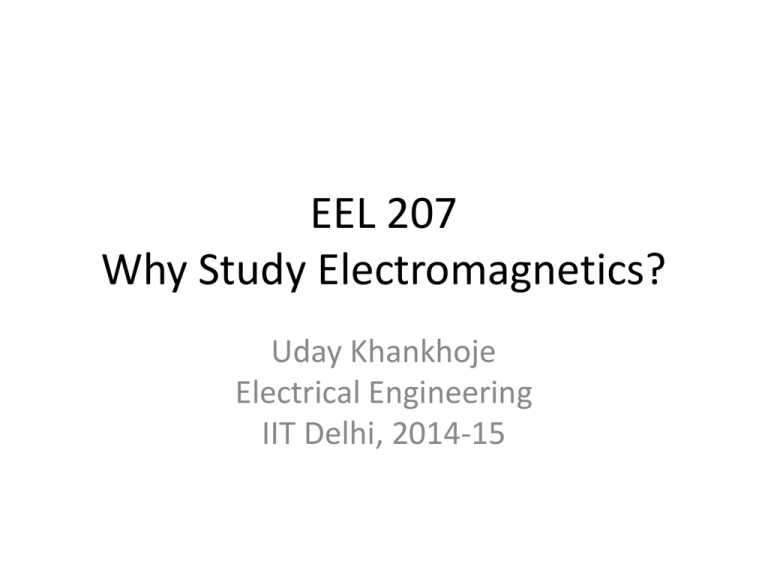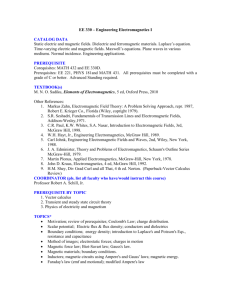slides
advertisement

EEL 207 Why Study Electromagnetics? Uday Khankhoje Electrical Engineering IIT Delhi, 2014-15 Why Study Electromagnetism? Plasma propulsion Optical fibres Radars Cell towers Why Study Electromagnetism? LCD screens Radio astronomy GPS Motors Electromagnetic Spectrum [8] EM Applications over time • 1900 – 1990s: Dominated by military applications – Radar, stealth technology, electromagnetic weapons, etc. • 1990s – today: – Computing – Communication – Imaging (bio-medical, remote-sensing, groundpenetrating radar, oil well exploration, etc.) Military applications [1] 100 MHz radar wave interacts with a fighter jet. False colours correspond to induced surface currents which re-radiate EM energy High-speed circuits Circuit theory is actually a subset of electromagnetic field theory: At high switching speeds, signals are not confined to circuit paths! Shrinking circuit size + high speed operation => Higher coupling between circuit elements via EM Near magnetic field above a packaged integrated circuit.[2] High-speed circuits Microchip embedded within a dual inline IC [1] Fields associated with a logic pulse are not confined to metal paths Micro-cavity Laser Design Periodic air holes in a slab – Photonic Crystal Simulation showing trapped electro-magnetic fields [7] Used for making ultra-compact lasers, quantum-entanglement devices, etc. Photonic integrated circuits [5] Circuits for light : simple example of a wavelength dependent filter. At the resonance frequency of the loop, output drops off. Photonic integrated circuits [6] Optical Fibres [4] Photonic crystal fibres Conventional fibres In addition to simply guiding light, gives control over dispersion, polarization properties, non-linear effects, etc. Human Body Imaging : medicine Tumour region has different refractive index as compared to surrounding fatty tissue [1] Reconstruct refractive index profile based on scattered electromagnetic fields Surround the tissue by antennas: properties of the scattered electromagnetic energy depends on refractive index distribution Human Body Imaging : security Very active area of research : terahertz frequency (millimetre wavelength) sources and detectors. [3] Conclusions • Study of EM is fundamental to most applications of computing, circuit design, and communications • Many prominent future technologies are highly dependent on a sound understanding of EM: quantum computing, high-speed optical inter-connects, wireless power transfer References [1] Taflove, Allen. "Why study electromagnetics: the first unit in an undergraduate electromagnetics course." Antennas and Propagation Magazine, IEEE 44.2 (2002): 132-139. [2] http://www.cvel.clemson.edu/emc/ic_emc/ic.html [3] http://projektas-kalejimai.blogspot.in/2011_11_01_archive.html [4] http://www.intechopen.com/books/advances-in-photonic-crystals/photoniccrystals-for-optical-sensing-a-review [5] http://www.tnw.tudelft.nl/en/about-faculty/departments/imagingphysics/research/researchgroups/optics-research-group/research/integratedphotonics/ [6] Imanol Andonegui and Angel J. Garcia-Adeva. “Designing integrated circuitry in nanoscale photonic crystals” http://spie.org/x104683.xml [7] O. Painter, R. K. Lee, A. Scherer, A. Yariv, J. D. O’Brien, P. D. Dapkus, and I. Kim, “Two-dimensional photonic band-gap defect mode laser,” Science, vol. 284, June 11, 1999, pp. 1819–1821. [8] Ulaby, Michielssen, Ravaioli, “Fundamentals of Applied Electromagnetics”, Pearson 6th ed.











